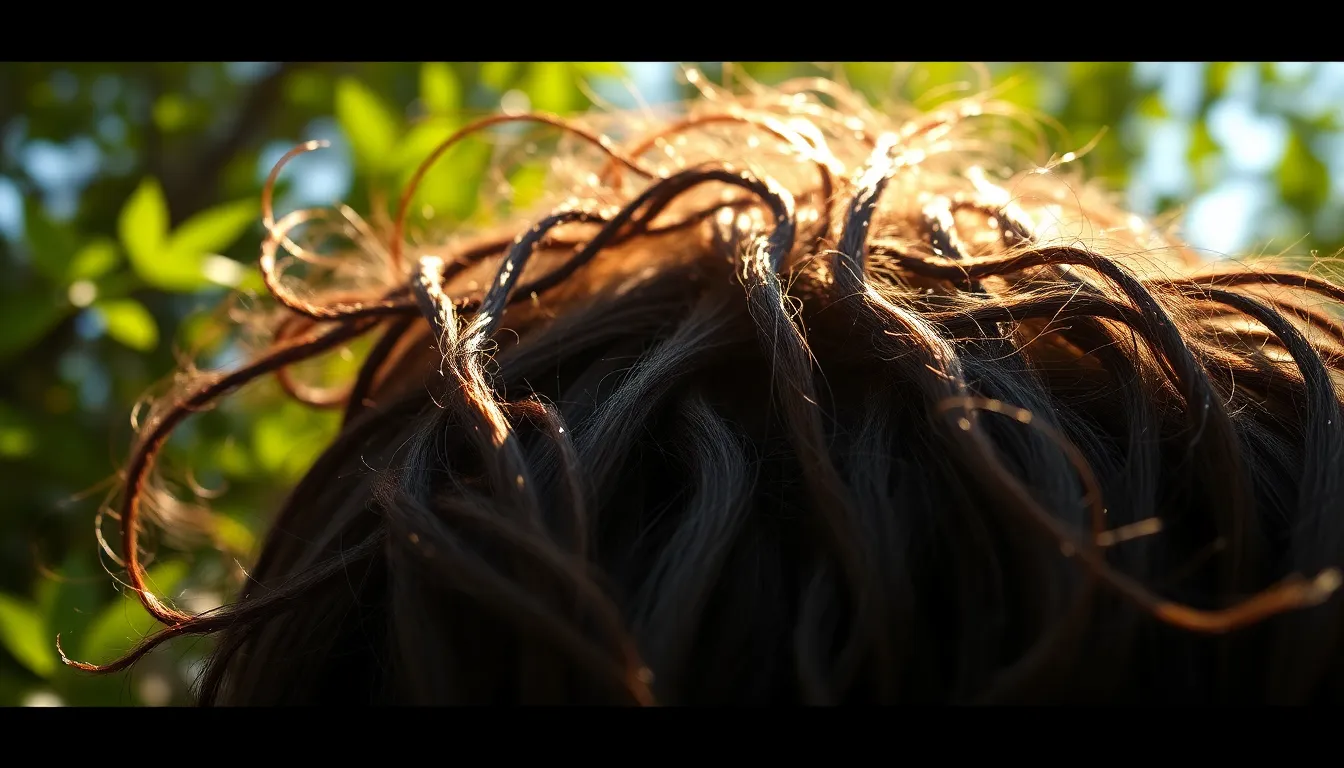Table of Contents
ToggleGetting tree sap in your hair can feel like a sticky nightmare. One moment you’re enjoying a lovely day outdoors, and the next, you’re stuck with a gooey mess that seems determined to become your new hairstyle. Don’t panic! There’s a way out of this sticky situation, and it doesn’t involve a pair of scissors or a drastic haircut.
Understanding Tree Sap
Tree sap poses a common challenge for individuals who spend time outdoors. Awareness of its properties and origins aids in successful removal from hair.
What Is Tree Sap?
Tree sap serves as a vital fluid in trees, containing water, nutrients, and sugars. It acts as a defense mechanism, sealing wounds and warding off pests. In its natural state, sap is sticky and can harden over time, complicating removal. Certain types of sap, like pine sap, are particularly notorious for their adhesive qualities. Understanding these traits simplifies the cleaning process later on.
Common Sources of Tree Sap
Oak, pine, and maple trees represent frequent sources of tree sap. Individuals often encounter sap during hiking, camping, or playing near these trees. Areas with heavy winds or storms tend to see more sap leakage due to branch damage. Furthermore, summer months increase sap production as trees respond to environmental conditions. Recognition of these sources helps individuals avoid sticky situations.
Why Is Tree Sap Problematic?

Tree sap poses several challenges, particularly when it gets stuck in hair. Its sticky and viscous nature complicates removal, leading to frustration.
Effects on Hair
Tree sap can cause tangling and matting in hair strands. Gummy residues adhere to hair fibers, making it challenging to brush or comb through. Some individuals may experience dryness and breakage as sap pulls on delicate strands. Prolonged contact with sap can lead to a build-up that requires intensive cleaning methods for removal. Direct exposure to certain saps may also result in scalp irritation for some people.
The Importance of Timely Removal
Timely removal of tree sap is crucial to prevent hair damage. The longer sap stays in hair, the harder it becomes to eliminate. Immediate action reduces the risk of tangling and minimizes cleanup difficulty. Tackling sap quickly also helps preserve the hair’s natural moisture and integrity. Neglecting prompt removal can lead to frustrating salon visits, where significant hair cutting might be necessary. Addressing sap issues as soon as possible saves time and effort in the long run.
Effective Methods to Remove Tree Sap
Removing tree sap from hair can be straightforward with the right methods. Several household items can effectively tackle sap.
Household Items
Oil-based products work well for dissolving tree sap. For instance, olive oil or coconut oil can be applied directly to the affected area. Rubbing alcohol also serves as an effective solvent for sap removal. Using a cotton ball, he or she can apply it on the sap, letting it sit for a few minutes before combing through. Vinegar can assist in breaking down the stickiness. Mixing equal parts of vinegar and water and using a spray bottle helps in this process. Clean cloths support thorough removal by wiping away any residue.
Commercial Products
Numerous commercial products target sap removal efficiently. Adhesive removers, available at most hardware stores, can confidently eliminate tree sap. These products specifically break down sticky substances, making cleanup simpler. A specialized sap remover designed for hair also exists, providing a tailored solution. Users must follow the instructions for best results. Furthermore, some shampoos formulated for sticky substances may offer additional benefits. Shampoos claiming to be strong enough to remove tough residues can restore hair’s cleanliness.
Professional Help
When home methods fail, seeking professional help becomes an option. Stylists equipped to handle sap removal can ensure safe and effective treatment. They possess knowledge about various techniques and products that can remove sap without damaging hair. Keratin treatments may provide an added level of care, making hair healthier after removal. Consulting a professional stylist becomes necessary for severe cases, especially when significant damage risks exist. Therefore, it’s best to consider this option when self-treatment proves challenging.
Preventing Tree Sap Hair Issues
Avoiding tree sap in hair requires simple yet effective strategies during outdoor activities. Awareness of surroundings plays a key role.
Tips for Avoiding Tree Sap
Stay clear of trees known for sap production. Pine, oak, and maple trees frequently exude sap, especially in warm, windy weather. Planning outdoor activities in open areas reduces exposure. Wearing a hat provides an extra layer of protection, creating a barrier against falling sap droplets. Keeping hair tied back can minimize contact between hair and sticky residues. Also, applying a lightweight leave-in conditioner may create a barrier, making sap removal easier if exposure occurs.
What to Do After Exposure
Immediate action proves crucial after hair contacts tree sap. Assess the affected area and apply an oil-based product to the sap. Alternatives like coconut oil or olive oil work to break down the sticky substance. Gently massage the oil into the affected strands to dissolve the sap. While some may opt for rubbing alcohol or vinegar, oil is generally a milder solution. Always wash hair thoroughly afterward with shampoo to remove any remaining residues. Following exposure, consider a deep conditioning treatment to restore moisture and repair potential damage.
Dealing with tree sap in hair can be a hassle but it’s manageable with the right approach. By acting quickly and using effective removal methods like oil-based products or rubbing alcohol, individuals can save their hair from damage. Preventive measures can also go a long way in avoiding sticky situations during outdoor activities. Staying aware of surroundings and taking precautions can help minimize the risk of sap getting tangled in hair. When in doubt, seeking professional help ensures a safe and effective solution. With these tips in mind, enjoying nature doesn’t have to come with the frustration of tree sap.




